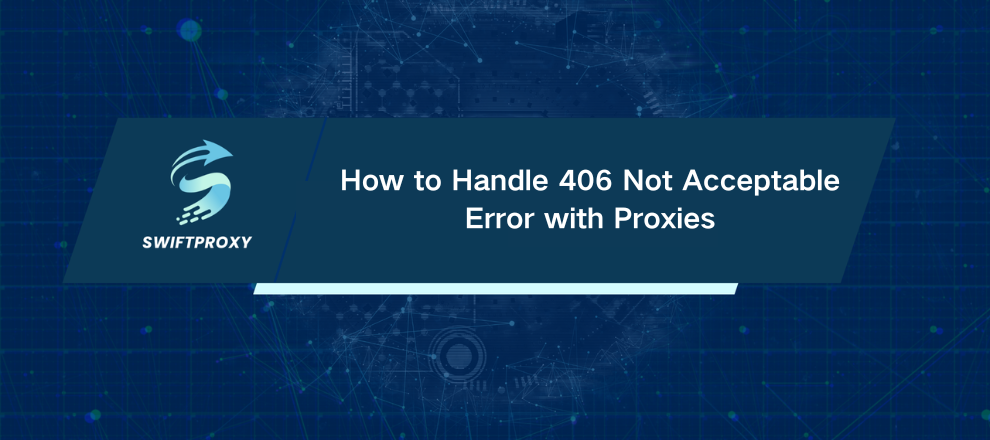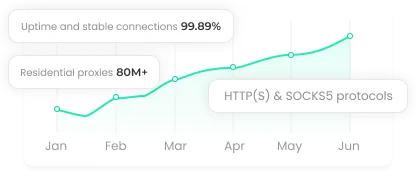How to Handle 406 Not Acceptable Error with Proxies

Web errors can feel like invisible roadblocks—sudden, frustrating, and sometimes cryptic. Among these, the 406 Not Acceptable error is particularly sneaky. Unlike the well-known 404, which screams "Not Found," the 406 quietly signals a mismatch between what your client requests and what the server can provide. For anyone relying on proxies for large-scale data collection or web scraping, this error can halt operations in their tracks.
Let's break it down, and by reading this article, you will have practical solutions ready to implement.
Introduction to the 406 Not Acceptable Error
A 406 error originates on the client side. Your browser or script sends a request, and the server responds: "I can't deliver the content in a format you asked for."
This boils down to content negotiation. Your client says, "I can read this type of file, speak this language, handle this encoding," and the server tries to match it. If it can't, boom—406.
The main culprits? The Accept headers in your HTTP request. These tell the server what you can handle:
Accept: Specifies the content type, like text/html or application/json.
Accept-Encoding: Tells the server which compression methods you can handle, like gzip or br.
Accept-Language: Signals your preferred language.
Accept-Charset: Declares supported character sets, such as UTF-8.
If any of these headers conflict with the server's available resources, the 406 error pops up.
Why Proxies Make 406 Errors More Common
Proxies can complicate things in subtle ways:
Header Modification: Some proxies strip or alter Accept headers. Even a small tweak can trigger a 406.
Outdated User-Agent Strings: Old or generic User-Agent headers can raise server flags.
Server Security Rules: Sites often detect and block unusual traffic patterns, including those from proxies.
Misconfigured Proxy Settings: Wrong ports, credentials, or software settings can send malformed headers.
Geolocation Issues: Some servers only serve content to certain regions. If your proxy's IP is "out of bounds," you may hit a 406.
Step-by-Step Fix for 406 Errors
Here's how to systematically resolve the 406 when using a proxy:
1. Inspect and Adjust Request Headers
Check the Headers: Use your browser's developer tools or your HTTP client library to inspect requests.
Broaden Accept Headers: Don't restrict your request too much. For example, instead of only application/json, try */* to accept all content types.
Emulate a Real Browser: Ensure a modern User-Agent string and complete standard headers. This reduces suspicion from servers.
2. Verify Your Proxy Configuration
Double-Check Settings: Confirm host, port, username, and password are correct.
Test a Different Proxy: Swap in another proxy to see if the issue persists. If it clears, your original proxy is the problem.
Upgrade to a Premium Proxy: Services like Swiftproxy offer real residential IPs and intelligent rotation, drastically reducing 406 errors.
3. Adjust for Server-Side Constraints
Validate URLs: Typos or incorrect endpoints can trigger errors.
Debug Your Application: Logic or coding errors can send malformed headers. Fixing them often resolves the 406.
How Swiftproxy Makes 406 Errors Rare
Premium proxy services go beyond basic IP rotation. Swiftproxy offers:
Authentic Residential IPs: Servers see requests as coming from real users. Less suspicion, fewer errors.
Smart IP Rotation and Sticky Sessions: Rotate IPs automatically or maintain a consistent identity for complex workflows.
Global Reach: Access content from trusted geographic regions to avoid location-based blocks.
High Performance: Stable, fast connections ensure requests aren't dropped or misread by servers.
Seamless Integration: Easy setup with dashboards and APIs. Works across scripts, languages, and tools.
Conclusion
406 Not Acceptable errors can stop data collection cold—but they're not unsolvable. Inspect your headers, optimize your proxy setup, and leverage premium services like Swiftproxy to prevent interruptions. With the right approach, these errors become minor speed bumps rather than major roadblocks.
Master the headers. Choose smart proxies. And keep your workflow running smoothly.

















































